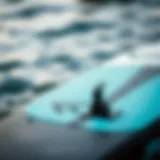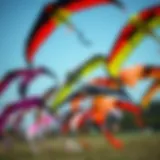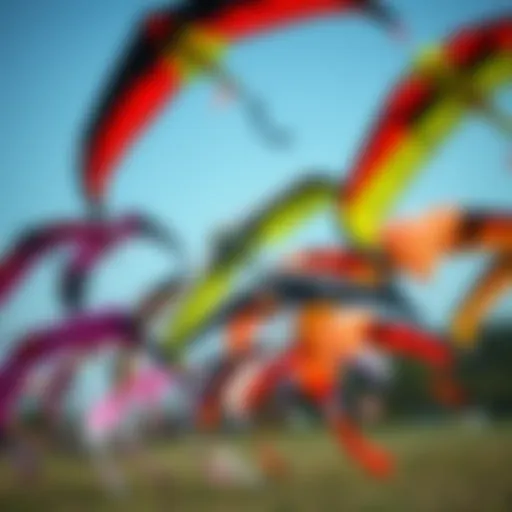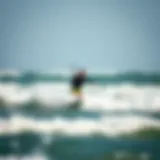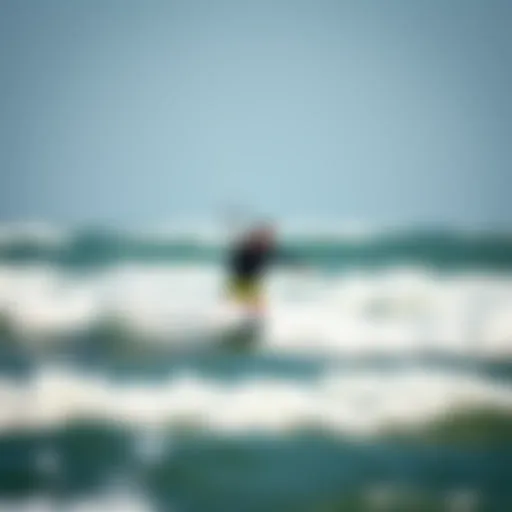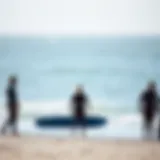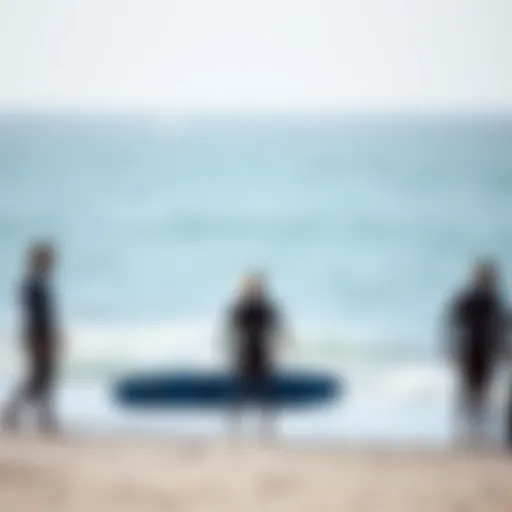Wings for Sale in Kiteboarding: A Detailed Overview
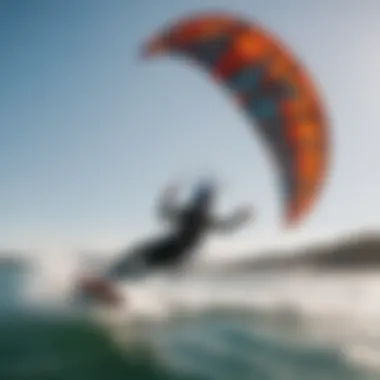

Intro
Kiteboarding is more than just a sport; it’s an exhilarating experience that touches the very essence of adventure. For enthusiasts and novices alike, understanding the nuances surrounding wings for sale is crucial for elevating one’s kiteboarding journey. Wings have evolved significantly over the years, adapting to both technology advancements and the desires of riders. This guide aims to cut through the clutter, shedding light on the significance of wing design and aiding you in making informed choices when buying. Along the way, we’ll explore not only the performance enhancements that the right wing can bring but also the factors that should shape your purchasing decisions.
Gear Insights
In the realm of kiteboarding, gear stands as the backbone of performance and safety. Choosing the right wings can make the difference between a day of frustration and an unforgettable ride.
Latest Gear Reviews
The world of wings is vast, and keeping up with the latest developments can be daunting. Recent additions in the market include brands like Duotone, Naish, and Ozone, each showcasing unique features aimed at catering to different skill levels and riding styles. For instance, the Duotone Echo has gained immense popularity among wave riders for its intuitive handling and responsiveness.
Furthermore, the Naish Hover offers versatility, allowing riders to engage in both soaring and racing, while also providing stability in gusty conditions. Reviews suggest that a crucial factor to consider when evaluating these wings is the material used; lightweight yet durable fabrics can significantly enhance on-water performance.
Essential Gear for Beginners
If you’re just dipping your toes into the kiteboarding waters, finding the right gear can set you up for success. Here’s a breakdown of essentials:
- Wings: For beginners, opting for larger wings can provide better lift and stability. Look for options with easy relaunch capabilities.
- Harnesses: Your choice of harness impacts your comfort and control. A waist harness might feel less constricting, whereas a seat harness can offer excellent support.
- Leashes: A reliable leash is paramount for safety. Ensure it’s of appropriate length and tethered securely to your wing.
"Choosing the right gear is more than aesthetics; it's about fostering a connection with the wind and water that defines kiteboarding."
Techniques and Tips
Understanding the gear is just one slice of the kiteboarding pie. Technique and safety are equally important to ensure your sessions are enjoyable.
Advanced Tricks and Techniques
For those of you looking to push your limits, mastering techniques like downloops or transitions can add flair to your riding. These tricks require fine-tuning your control over the wing and board. The key is to gradually increase the complexity of the maneuvers, starting with simple jumps before venturing into flips and spins.
Safety Practices for Kiteboarders
While the thrill is undeniably captivating, safety should never take a backseat. Here are a few pointers to keep in mind:
- Always check weather conditions. Winds can change swiftly and can significantly alter ride experience.
- Use safety systems. Make sure your gear comes with proper depower mechanisms that allow for quick responses in unexpected situations.
- Stay within your limits. Pushing beyond what you are comfortable with can lead to accidents and injuries.
These tips and more will navigate you through your kiteboarding journey, enriching not just your rides but your entire experience.
As we delve deeper into these insightful dimensions, you’ll find that understanding wings holds the key to unlocking greater enjoyment in the air and water.
The Evolution of Kiteboarding Wings
The narrative of kiteboarding is one that glides gracefully through time, with wings playing a pivotal role in shaping the sport. Understanding the evolution of these wings offers valuable insights into their design, functionality, and the broader context of kiteboarding itself.
It’s important to recognize that kiteboarding isn’t just about riding the waves; it’s also about the engineering marvels that propel riders into the air and across the water. As technology and design flourished, so too did the performance capabilities of wings, providing riders with increasingly dynamic experiences. This evolution illustrates a significant shift in how enthusiasts approach the sport, catering not just to fun but also to performance and skill enhancement. Each era of wing design intertwines with the development of kiteboarding techniques, showcasing a rich tapestry of innovation.
Historical Context
The origins of kiteboarding wings can be traced back to the concepts of simpler kites used by the ancient Chinese, serving more practical purposes like lifting, signaling, or even fishing. It wasn’t until the late 20th century that the first modern kites began to emerge for the sport. The late 1990s marked a groundbreaking period, as pioneers in the kiteboarding scene began to experiment with shapes, materials, and structures that could withstand the forces of wind and water.
Such early innovations like the inflatable kite fundamentally changed the game, allowing for greater lift and control. Riders soon recognized that different wing designs affected their maneuvers and stability, giving rise to various styles and preferences. People didn’t just play; they thrived on the nuances that these wings provided, from gradual float to aggressive, quick dives. The historical milestones are not just dates; they represent leaps in creativity that now define how we ride, giving kiteboarding its modern flair.
Technological Advances
The journey of kiteboarding wings mirrors a striking trajectory of technological progress. As the materials evolved, so did the design capabilities. In the past, wings were primarily made from lower-quality fabrics. Today, advanced materials like rip-stop nylon or mylar have taken center stage, ensuring durability and enhanced performance.
Added to this is the advent of computer-aided design, which allows engineers to simulate and optimize wing shapes before creating physical prototypes. The result? Wings that are more efficient in translating wind energy into lift and speed, and that respond adeptly to the rider’s input.
Additionally, the integration of struts in designs has drastically improved stability. Riders can harness the wind's energy more effectively, leading to a more enjoyable experience. The technological explosion also led to specialized wings—for instance, those designed explicitly for racing speed demons versus leisure riders gliding through gentle breezes.
Influential Designs
As we look at influential designs in kiteboarding wings, one can’t overlook the importance of determining what works best for environmental conditions and rider goals. The progression from simple framed kites to sophisticated leading-edge inflatables and foil boards highlights the ingenuity of kite designers.
Each key design has contributed to defining user experiences; for example, the unmatched ability of the inflatable kite to stay afloat during crashes redefined how riders experiment with flips and rolls in their routines.
Foil wings, meanwhile, have gained traction in the past decade due to their lightweight construction and speed potentials, enabling riders to skim over water with remarkable ease. These designs have paved the way for highly specialized racing divisions and recreational practices alike, illustrating that innovation within wing design directly shapes the kitesurfing community.
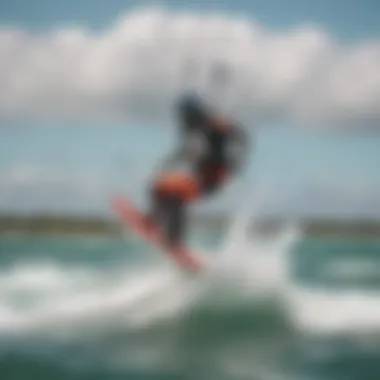

Understanding Wing Types
When it comes to kiteboarding, understanding different wing types is essential for both novices and seasoned surfers. The wings you choose will directly impact your riding experience, influencing factors like speed, control, and comfort on the water. In essence, selecting the right wing isn’t just a matter of taste; it's about understanding how each design functions and performs under various conditions. This section aims to clarify these crucial categories, making it easier for you to make an informed choice.
Foil Wings
Foil wings have taken the kiteboarding world by storm, but what makes them stand out? They feature a rigid structure, often made from lightweight materials like carbon or fiberglass. This design offers an impressive lift-to-drag ratio, meaning you can glide smoothly on the water even when the wind isn't roaring.
Here are some key characteristics to consider:
- Performance: Foil wings are known for their ability to generate lift quickly, making them ideal for lighter wind conditions. You can confidently venture out when others are stuck on the shore, feeling the exhilaration of flying across the water.
- Speed: Once you've nailed your technique, these wings can propel you at impressive speeds. Riders often find that their overall agility improves, allowing for quick turns and playful maneuvering.
- Handling: Though responsive, foil wings may require a bit of a learning curve; they tend to be less forgiving for beginners. It’s recommended to have some experience before tackling these types.
Leading Edge Inflatable (LEI) Wings
Leading Edge Inflatable (LEI) wings are perhaps the most familiar sight on the water. These inflatable structures offer a versatile option that appeals to a broad range of riders.
Why choose LEI wings? Here are some benefits:
- Stability: The inflatable design allows for excellent stability, even in gusty winds. It covers you from abrupt changes that could throw off your balance, giving you more confidence as you ride.
- Convenience: They pack down easily for transport, making them great for travelers or those with limited storage space. Unrolling your gear and getting ready to hit the waves can be done in a snap.
- Adaptability: These wings are suitable for a variety of conditions. Want to ride in strong winds? They’ll handle it. Prefer a leisurely session in gentler breezes? No problem. LEI wings offer a lot of versatility in that department.
Hybrid Wings
Hybrid wings are a fresh amalgamation of foil and traditional designs, creating something unique for the kiteboarding community. They aim to offer the best of both worlds, blending lift and stability with the ease of maneuverability.
Consider these aspects:
- Versatile Performance: Whether you’re looking for speed or lift, hybrid wings cater well to a range of riding styles. You can switch from a casual cruise to a more aggressive session without worrying about the gear failing you.
- User-Friendly: These wings often have a less steep learning curve, which makes them appealing to those who are just dipping their toes into the sport. They offer stability while also encouraging progress in your techniques.
- Comfort: Hybrid wings maintain a sense of comfort through various maneuvers, allowing you to concentrate on your ride rather than struggling with gear.
Understanding wing types is a game-changer for your kiteboarding journey. Delving into the specifics helps to elevate your performance. You may find that one wing type resonates more, enhancing your riding experience by offering tailored control and responsiveness.
"Choosing the right wing is like picking the right tool for a job; it enhances your capability and can transform your experience on the water."
Taking the time to learn about the intricacies of each option will undoubtedly pay off in your future rides.
Key Considerations When Buying Wings
When diving into the world of kiteboarding, picking the right wing is no walk in the park. Understanding the intricacies of wing selection can greatly enhance your experience on the water. Each element in the decision-making process plays a critical role, from your skill level to wind conditions. The sheer variety of options can be dizzying, but prioritizing these considerations will set you on the right path toward finding the perfect wing. Here’s a closer look at the key factors to keep in mind.
Skill Level Appropriateness
Your skill level stands tall as a deciding factor when choosing a wing. Beginners require wings that offer stability and ease of use, allowing them to focus on mastering the basics without any additional hurdles. Novice kiteboarders often fare better with wings that have a larger surface area. This design typically provides more lift and makes it easier to catch wind.
Conversely, more experienced riders might lean towards wings that cater to high performance. They may prefer a tighter turning radius and increased speed. These wings tend to be more responsive, demanding practice and skill to harness effectively. Keep in mind that choosing the right wing for your skill level will not only enhance your experience but also build your confidence on the water.
Wing Size and Surface Area
The size of the wing you opt for can make or break your ride, literally! A wing's size in kiteboarding, measured in square meters, strongly influences its performance. Generally, larger wings are suited for lighter winds, as they can capture more air and provide ample lift. This makes them an excellent choice for those less breezy days where you would otherwise hit dead water.
On the flip side, smaller wings excel in high winds. They are typically more manageable and allow for quicker maneuvering. However, they may not provide the same lift as their larger counterparts. Finding the sweet spot involves balancing your typical riding conditions with your weight and desired speed. Don't shy away from experimentation here; it could unlock new tricks and styles!
Wind Conditions Compatibility
Wind conditions play a pivotal role in kiteboarding, and the right wing can transform a mediocre day into an exhilarating session. Every wing has its sweet spot when it comes to wind speed. Understanding this nuance is like knowing the back of your hand for an avid kiteboarder.
For example, if you’re seeking thrill on gusty days, a wing that offers good depower capabilities will be your best buddy. Depower allows riders to adjust to sudden wind shifts without losing control. Meanwhile, if you’re cruising on stable winds, a wing designed for direct power can give you the edge to cut through the water smoothly. Monitor local weather patterns and patterns in wind behaviour before making your purchase. It can be a game-changer.
Budget and Quality Balance
Last but not the least, let’s talk about budget. The kiteboarding market is rife with options landing at various price points. On one end, you’ll find budget models that come with basic features, but they often lack the durability and performance enhancements seen in higher-priced wings. However, a common pitfall to dodge is sacrificing quality for a lower price — it's a classic case of you get what you pay for.
Investing in a reputable brand with solid construction can save you headaches down the line, especially when repairs start racking up. Instead of jumping on the cheapest option, try to look for wings that strike a balance between cost and build quality. This means considering warranties, brand reviews, and performance. Remember, a well-made wing not only enhances your experience but can also minimize replacements down the road.
"A penny saved is a penny earned, but a well-spent penny can lead to an unforgettable Adventure" – Choose wisely!
Arming yourself with knowledge in these key areas allows for more informed decisions, setting you up for a splendid time on the water. By considering your skill level, wing size, wind conditions, and budget, you’re setting the stage for the ultimate kiteboarding experience.
Assessing Performance Metrics of Wings
When diving into the world of kiteboarding, understanding the performance metrics of wings is essential. These metrics determine how well a wing will perform in various conditions, which directly impacts the overall kiteboarding experience. Knowing how to assess elements like lift and drag ratios, stability and handling, and speed and agility can make the difference between a thrilling ride and a frustrating one. Here, we’ll unpack these critical metrics.
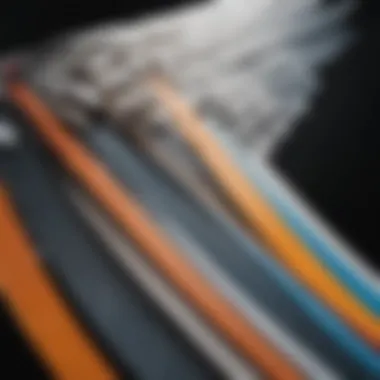

Lift and Drag Ratios
Lift and drag ratios are fundamental to evaluating a wing's performance. The lift generated is what allows a kiteboarder to rise and stay aloft, while drag is the opposing force that works against that upward movement. Balancing both forces is crucial for optimal performance.
- Importance of Lift: When the lift is high relative to drag, the kite can rise quickly and maintain altitude with less effort. A wing with a good lift-to-drag ratio allows riders to catch air and achieve jumps more effectively.
- Impact of Drag: High drag can hinder performance, making it difficult for kiteboarders to accelerate and maneuver. The goal is to find a wing that minimizes drag while maximizing lift.
For instance, wings designed with specialized profiles, like those using advanced materials, can dramatically enhance these metrics. Many experienced kiteboarders suggest testing different wings to feel firsthand how lift and drag can affect riding.
Stability and Handling
Stability and handling go hand in hand, greatly influencing a kiteboarder's experience on the water. A stable wing maintains its structure under varying conditions, providing confidence to the rider. Handling refers to how responsive and controllable the wing is when in use.
- Why Stability Matters: A stable wing reduces the risk of sudden drops or erratic movements that can throw off a rider's balance. This stability helps maintain a seemingly effortless ride, especially in challenging wind conditions.
- Handling Characteristics: Wings that handle well allow for quick turns, swift adjustments, and fluid motion, making them fun and safe to ride. Many riders prefer a wing that offers a balance between stability and agility, enabling them to navigate tricky spots.
Experienced kiteboarders often emphasize the significance of proper tuning to enhance stability and handling. Small adjustments can lead to notable improvements, making it worthwhile to experiment.
Speed and Agility
Speed and agility in kiteboarding are as critical as they are exhilarating. The metrics of speed and agility determine how fast a rider can move and how effortlessly they can change directions.
- Speed Evaluation: A kite that can achieve higher speeds gives riders an adrenaline boost and allows for more advanced maneuvers. Furthermore, the ability to reach speed quickly can be essential in choppy waters, where maintaining momentum is key.
- Agility Factor: Agility refers to how quickly a wing can turn and respond to the rider’s inputs. A highly agile wing allows for dynamic riding and sharp turns, enabling kiteboarders to adapt to changing conditions on the fly. Without agility, a kite can feel cumbersome, even at higher speeds.
"In kiteboarding, it’s not just about the wind; it’s about how the wing’s performance metrics blend together, offering a seamless experience on the water."
Selecting a wing with the right balance of speed and agility can elevate the kiteboarding experience to new heights. Ultimately, the best way to gauge these metrics is by practical experience, paired with feedback from other riders and reviews.
By assessing these performance metrics—lift and drag ratios, stability and handling, speed and agility—riders can make informed decisions, ensuring they find the perfect wing for their adventures. This understanding not only enhances their riding but also deepens their connection to the thrilling sport of kiteboarding.
Market Trends in Kiteboarding Wings
As the kiteboarding world continues to grow, so does the market for wings. Understanding market trends in kiteboarding wings is pivotal for anyone looking to make informed purchasing decisions. Trends not only reflect the current state of product offerings, but they also indicate shifts in rider preferences and advancements in technology. By keeping an eye on these trends, kiteboarders can better align their choices with their personal needs while considering elements such as performance, sustainability, and innovation.
Emerging Brands and Innovations
In recent years, a number of emerging brands have entered the kiteboarding scene, challenging the status quo established by long-standing companies. These brands often take a fresh approach, bringing unique designs and innovations to light that appeal to modern kiteboarders.
- New Materials: For instance, brands like Duotone have started to embrace lighter, yet more durable materials, leading to wings that offer both longevity and enhanced performance.
- Design Innovations: Other companies, such as North Kiteboarding, focus on unique wing shapes that cater to specific needs; whether that be superior lift or easier handling in tricky conditions.
- Advanced Technology: Integration of technology in design, like the use of computer simulations for wind flow analysis, allows new entrants to create wings that respond better to user input and environmental conditions.
Despite their novelty, these brands are gaining traction and have built a loyal customer base. This is significant not only for the industry but also offers seasoned brands a dash of competition, pushing everyone to elevate their offerings.
Sustainability Initiatives
Today, sustainability is more than just a buzzword; it’s become a critical consideration in the kiteboarding industry. As environmental awareness rises, brands are stepping up, driven by both consumer demand and a sense of responsibility. Kiteboarding wings are increasingly made with eco-friendly materials and practices:
- Biodegradable Fabrics: Some brands are experimenting with fabrics that break down in the environment, thus reducing their impact once they reach the end of their lifespan.
- Recycling Programs: Companies like Ozone have initiated recycling programs, urging enthusiasts to return old wings for proper disposal or upcycling.
- Transparent Supply Chains: More brands are being transparent about their manufacturing processes, informing consumers on how and where their products are made, ensuring ethical sourcing and labor practices.
"Sustainability isn't just a trend; it's a movement that shapes our kiteboarding future."
Through these sustainability initiatives, companies aim not only to appeal to eco-conscious consumers but also to set a new industry standard that ensures future generations can enjoy the thrill of kiteboarding without compromising the health of our planet.
Staying abreast with these market trends allows kiteboarders, instructors, and adventurers alike to make choices that align with their values and needs, ensuring a thrilling and responsible kiteboarding experience.
Where to Find Wings for Sale
Finding the right wings for kiteboarding is like searching for the perfect wave; it requires patience, knowledge, and often an adventurous spirit. The hunt for a wing isn't just about the act of purchasing; it involves understanding the nuances of what fits your style, skill level, and performance needs. The availability of wings has broadened tremendously, which means you've got options to explore, but knowing where to look can save time and money. This section dives into the various avenues for acquiring these essential pieces of gear, ranging from local shops to the depths of online marketplaces and second-hand deals.
Local Retailers
Visiting local retailers provides a hands-on experience that online shopping simply can’t match. Here, you can physically inspect wings, gauge their materials, and talk to knowledgeable staff who can offer personalized advice based on your specific requirements. Local shops often carry the latest models and may even allow you to demo wings before making a decision. Engaging with experienced kiteboarders at these venues can enhance your understanding:
- Assess Quality: Feel the fabric, check the seams, and examine the stitching. Locally, you might discover that some brands have certain reputations for durability, which is critical given the rigors of kiteboarding.
- In-Person Support: Should any mishap occur, establishing a relationship with a local shop means that support and repairs can be more accessible.
Moreover, many local shops host community events or workshops—great opportunities to meet other kiteboarding enthusiasts and learn from their experiences. Ultimately, while prices may be higher than online, the value gained from expert guidance can be invaluable.
Online Marketplaces
The digital landscape has transformed how we shop, and online marketplaces have bombed onto the scene as a great alternative for sourcing wings. Websites like eBay, Amazon, or Kiteboarding-specific platforms offer vast selections at competitive prices
- Convenience: Your favorite wings can be just a few clicks away, allowing you to browse at your leisure and compare various models without leaving your couch.
- Price Comparisons: Easily compare prices across different platforms to ensure you're getting the best deal possible. Sales and discounts are frequent in the online world, so you might just strike gold.


However, there are some downsides to consider:
- Lack of Physical Inspection: When you order online, you don't get to touch or test the wings beforehand. This can lead to surprises upon arrival.
- Shipping Costs: Always factor in potential shipping fees, especially if you’re buying large items like wings.
In summary, online marketplaces can provide an overwhelming range of choices but knowing how to navigate them effectively is essential for making reasonable purchases.
Second-Hand Options
Second-hand wings can be a great way to save some dough while still getting quality gear. Various avenues exist for finding pre-loved options, including local classifieds and specialized forums. Here’s what to keep in mind:
- Kiteboarding Community: Check local threads on Reddit or Facebook groups dedicated to kiteboarding. Often, enthusiasts buy new gear and sell their old wings for a fraction of the original price.
- Condition Awareness: It’s vital to inspect second-hand wings closely. Look for any wear and tear, check for leaks, and ask about repair history during interactions with the seller to gauge the wing’s reliability.
Though buying second-hand may come with uncertainties, many kiteboarders have scored fantastic deals that helped them get into the sport without breaking the bank.
"Finding the right wing is about balancing personal preference and budget, but don’t overlook exploring all available resources. "
Navigating the purchase landscape for kiteboarding wings should be an engaging journey, full of excitement about the potential of your new gear. Whether you choose the personalized touch of local retailers, the convenience of online marketplaces, or the treasure hunt that is second-hand shopping, each option holds advantages that can cater to your unique kiteboarding aspirations.
Care and Maintenance of Kiteboarding Wings
Taking care of your kiteboarding wings is not just a task; it’s a vital component of your overall kiteboarding experience. These wings face a myriad of environmental conditions, from saltwater and sand to wind and UV rays. Proper care ensures longevity, optimal performance, and safety on the water. If you treat your wings right, they'll reward you with smooth rides and enhanced performance, making sure you have a great time out there.
Proper Storage Techniques
Storing your kiteboarding wings correctly is a game changer. When you pack them up after an exciting day on the water, it’s tempting to just shove them in the bag or toss them in a corner. However, a little care in storage can prevent significant wear and tear.
- Avoid Sunlight: Just like how your skin needs protection from UV rays, so do your wings. Always store them in a shaded area or inside a protective bag when not in use. Sun exposure can degrade the materials, leading to reduced durability.
- Keep It Clean: Before storing, give your wings a good rinse with fresh water to remove salt, sand, and other debris. Leaving these elements on the fabric can cause damage over time. Avoid using harsh cleaners; a gentle rinse will do.
- Fold Properly: Instead of crumpling them up, practice folding the wings neatly. This not only saves space but also helps in maintaining the structural integrity of the wing's fabric. Storing them flat can avoid unnecessary creases or damage.
- Temperature Matters: Storing your wings at extreme temperatures (both high and low) can lead to material degradation. Try to keep them in a cool, dry place and avoid areas that can get too hot, like a parked car under the blazing sun.
By implementing these storage techniques, you'll prolong the lifespan of your wings and be ready to hit the waves whenever you please.
Cleaning and Repairs
Cleaning your wings may seem mundane, but it’s a must-do after every ride. Not doing so can lead to irreversible damage that might end up costing you. Here’s a simple breakdown of how to clean and perform minor repairs to your wings.
- Regular Checkups: After every session, take a moment to inspect your wings for any signs of wear. Look for punctures, fraying seams, or anything that might cause a hiccup next time you’re out.
- Simple Rinse: As mentioned earlier, a fresh water rinse goes a long way. After rinsing, let them dry fully before packing them up. This helps prevent mold and mildew, which can corrupt the fabric.
- Spot Cleaning: For stubborn stains, a soft cloth and a mild soap solution will often do the trick. Just be sure to rinse thoroughly to avoid soap residue.
- Repair Kits: Equip yourself with a kite repair kit. These handy kits usually include patches, adhesive, and other essentials to fix small holes or tears on the go. Any delay in repairing damages can lead to worsening conditions, ultimately affecting your experience in the water.
"Regular maintenance allows kiteboarding enthusiasts to enjoy the sport without interruptions, ensuring every session is as thrilling as the first."
If you notice significant damage or are unsure about how to proceed with repairs, don’t hesitate to consult with professionals. Taking these steps will not only maintain your wings but will also enhance your overall kiteboarding adventures.
User Experiences and Reviews
User experiences and reviews play a vital role in the kiteboarding community, particularly when it comes to choosing the right wings. They provide potential buyers insight into how different products perform in real-world scenarios, often shedding light on details that manufacturers might overlook. The subjective experiences shared by other users can guide newcomers and seasoned kiteboarders alike in making informed decisions, ultimately enhancing their activities on the water.
Case Studies from Enthusiasts
Anecdotal evidence gathered from kiteboarding enthusiasts can offer a treasure trove of information that mere specifications cannot. Take the example of Sarah, a kiteboarder from Oregon. She invested in a North Duotone Wing after reading various reviews praising its stability and performance in choppy waters. Sarah's journey with this wing highlights several key elements:
- Performance in Different Conditions: She noted how the wing behaved exceptionally well in gusty winds. Fellow users had emphasized this in their reviews, which corroborated her own experience.
- Durability Over Time: Many enthusiasts shared stories of wear and tear. Sarah faced some challenges too but appreciated the manufacturer’s prompt customer service when minor repairs were needed.
- User-Friendly: For someone like Sarah, who was transitioning from traditional kiteboarding, the positive feedback regarding ease of use made her pick this particular wing. It helped her feel more confident as she navigated a new aspect of the sport.
Such case studies foster a sense of community, bringing together experiences that might resonate. Thus, they add depth to the decision-making process for anyone looking to invest in kiteboarding wings.
Online Feedback and Rating Systems
In today's digital age, navigating purchasing decisions can hinge on online feedback and rating systems. Platforms like Reddit and KiteForum provide spaces for kiteboarders to leave comments and rate their experiences with various wings. Here’s why these systems matter:
- Diverse Perspectives: Users on these platforms often come from different backgrounds and regions, experiencing wings under various conditions. This diversity allows for a rounded view, making it easier to identify trends.
- Transparency of Information: Online reviews typically balance negative and positive aspects, giving a clear picture. For instance, if many reports indicate weight issues with a particular wing, potential buyers can weigh this against the benefits highlighted elsewhere.
- Rapid Updates on New Models: The kiteboarding market experiences frequent innovations. Online reviews help users stay updated with the latest models, discouraging impulsive purchases and promoting informed choices.
"Being able to tap into shared experiences can turn a daunting purchase into an exciting one—especially when you're venturing into wings for the first time."
Ending: The Future of Wings in Kiteboarding
As we wrap up our exploration of the dynamics surrounding wings in kiteboarding, it’s clear that the journey doesn't end here. The future of kiteboarding wings is ripe with potential, driven by innovation, sustainability, and a growing community of enthusiasts eager to push the boundaries.
Predicted Developments
Looking ahead, we can foresee a range of developments that promise to reshape the kiteboarding experience:
- Materials Advancements: With the emphasis on lighter, stronger materials, new composites will make wings more durable yet featherlight. This means kiteboarders can enjoy enhanced performance without weight slowing them down during their rides.
- Smart Technology Integration: Imagine wings equipped with sensors that provide real-time data on wind conditions and performance metrics. This tech could help kitesurfers optimize their rides and improve skill levels rapidly.
- Customization Options: As demand for personalized equipment grows, we may see suppliers offering wings that can be tailor-made to suit individual preferences – colors, sizes, and added features the rider can specify.
- Improved Eco-Friendliness: Sustainability will be at the forefront. More companies are likely to use recycled or eco-friendly materials, supporting a more environmentally conscious kiteboarding community.
The Ongoing Journey of Kiteboarding Innovation
Innovation is the lifeblood of kiteboarding, constantly driving the sport forward. It’s not just about enhancing equipment; it’s about how wings elevate the entire experience:
- Community Input: Riders are actively sharing their experiences online, leading to a feedback loop that informs manufacturers. Platforms like Reddit and Facebook have become forums where enthusiasts discuss what works and what doesn’t, allowing companies to make pivotal adjustments swiftly.
- Training and Safety Enhancements: As wings become more versatile, it also ensures that beginners enjoy smoother learning curves. Instructional methods evolve alongside equipment, meaning new riders can gain confidence more easily than ever.
- Expanded Accessibility: The right equipment can break barriers. Wings suitable for various skill levels can increase participation in the sport, leading to a more diverse community within kiteboarding.
